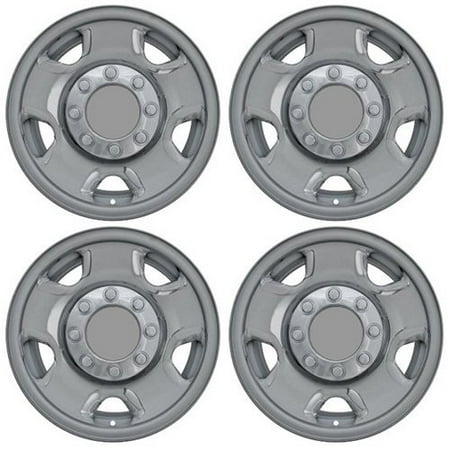17.5 inch quot;justquot; steel wheel cover rear axle
17 Inch Steel Wheels - One of the wheels can be a circular component that is intended to rotate while on an axle bearing. The wheel is one of many the different parts of the wheel and axle which are probably the six simple machines. Wheels, with axles, allow heavy objects to remain moved easily facilitating movement or transportation while supporting a lot, or performing labor in machines. Wheels can also be utilized for other purposes, maybe a ship's wheel, steering wheel, potter's wheel and flywheel.Common examples are only in transport applications. A wheel greatly reduces friction by facilitating motion by rolling together with the use of axles. In order for wheels to rotate, a short while has to apply to the wheel about its axis, either by gravity or by the effective use of another external force or torque.The English word wheel stems from the Old English word hweol, hweogol, from Proto-Germanic *hwehwlan, *hwegwlan, from Proto-Indo-European *kwekwlo-, a prolonged kind of the root *kwel- "to revolve, navigate around ".Cognates within Indo-European include Icelandic hjól "wheel, tyre", Greek κύκλος kúklos, and Sanskrit chakra, rogues both meaning "circle" or "wheel ".Precursors of wheels, also known as "tournettes" or "slow wheels", were known in your Middle East by your 5th millennium BCE (one of the first examples was discovered at Tepe Pardis, Iran, and dated to 5200–4700 BCE). We were holding composed of stone or clay and secured to the floor with a peg inside center, but required effort to turn. True (freely-spinning) potter's wheels were apparently drank in Mesopotamia by 3500 BCE and perchance since 4000 BCE, as well as oldest surviving example, that's present in Ur (modern day Iraq), dates to approximately 3100 BCE.
The original evidence of wheeled vehicles appears from the partner in the 4th millennium BCE, near-simultaneously in Mesopotamia (Sumerian civilization), the Northern Caucasus (Maykop culture) and Central Europe (Cucuteni-Trypillian culture), to ensure the question of which culture originally invented the wheeled vehicle continues unsolved.The earliest well-dated depiction of your wheeled vehicle (here a wagon — four wheels, two axles) is on the Bronocice pot, a c. 3500 – 3350 BCE clay pot excavated inside a Funnelbeaker culture settlement in southern Poland.The oldest securely dated real wheel-axle combination, that from Stare Gmajne near Ljubljana in Slovenia (Ljubljana Marshes Wooden Wheel) is already dated in 2σ-limits to 3340–3030 BCE, the axle to 3360–3045 BCE.2 kinds of early Neolithic European wheel and axle are known; a circumalpine sort of wagon construction (the wheel and axle rotate together, like in Ljubljana Marshes Wheel), and that of one's Baden culture in Hungary (axle just isn't going to rotate). They both of them are dated to c. 3200–3000 BCE.In China, the wheel was certainly present using the adoption with the chariot in c. 1200 BCE,although Barbieri-Low[9] argues for earlier Chinese wheeled vehicles, c. 2000 BC.
Related Images with 17.5 inch quot;justquot; steel wheel cover rear axle
17 Inch 6 Lug Chevy Steel Smoothie Wheels Autos Post
Chrome Wheel Skin Hub Covers With Center For 17x7 Inch 8 Lug Steel Rim

18+Chevy+Rally+Wheels Chevy 17 Inch Steel Wheels Autos Weblog
5x100 Steel Wheels Related Keywords amp; Suggestions 5x100 Steel Wheels
| TITLE: | 17.5 inch quot;justquot; steel wheel cover rear axle |
| IMAGE URL: | https://www.truckstyler-shop.de/bilder/produkte/gross/175-Zoll-gerade-Edelstahl-Radzierblende-Hinterachse.jpg |
| THUMBNAIL: | https://tse1.mm.bing.net/th?id=OIP.deigZO_hVL_V6KIxo1EDhQEsEs&pid=Api&w=180&h=181 |
| IMAGE SIZE: | 46774 B Bs |
| IMAGE WIDTH: | 800 |
| IMAGE HEIGHT: | 800 |
| DOCUMENT ID: | OIP.deigZO_hVL_V6KIxo1EDhQEsEs |
| MEDIA ID: | B4D7AEDDCF7FA6B1832EAD08BC05CE6594632C14 |
| SOURCE DOMAIN: | truckstyler-shop.de |
| SOURCE URL: | https://www.truckstyler-shop.de/175-inch-just-steel-wheel-cover-rear-axle- |
| THUMBNAIL WIDTH: | 180 |
| THUMBNAIL HEIGHT: | 181 |
Related Images with 17.5 inch quot;justquot; steel wheel cover rear axle
17 Inch 6 Lug Chevy Steel Smoothie Wheels Autos Post
Chrome Wheel Skin Hub Covers With Center For 17x7 Inch 8 Lug Steel Rim

Comments
Post a Comment